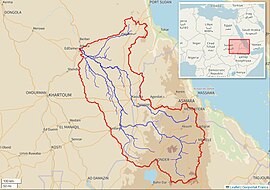| Atbarah River | |
|---|---|
 Upper Atbara and Setit Dam Complex Hydroelectric Power Plant | |
 Atbarah River Basin (Interactive map) | |
| Location | |
| Countries | |
| Physical characteristics | |
| Mouth | |
• location | Discharges into the Nile |
• coordinates | 17°40′41″N 33°58′25″E / 17.6781°N 33.9735°E |
| Length | 805 kilometres (500 mi) |
| Basin size | 69,000 square kilometres (27,000 sq mi) |
| Discharge | |
| • average | 374 m3/s (13,200 cu ft/s) |
The Atbarah River (Arabic: نهر عطبرة; transliterated: Nahr 'Atbarah), also referred to as the Red Nile and / or Black Nile, is a river in northeast Africa. It rises in northwest Ethiopia, approximately 50 km north of Lake Tana and 30 km west of Gondar. It then flows about 805 km (500 mi) to the Nile in north-central Sudan, joining it at the city of Atbarah (17°40′37″N 33°58′12″E / 17.677°N 33.970°E). The river's tributary, the Tekezé (Setit) River, is perhaps the true upper course of the Atbarah, as the Tekezé follows the longer course prior to the confluence of the two rivers (at 14° 10' N, 36° E) in northeastern Sudan. The Atbarah is the last tributary of the Nile before it reaches the Mediterranean.
For much of the year, it is little more than a stream. However, during the rainy season (generally July to October), the Atbarah rises some 18 ft (5 m) above its normal level. At this time, it forms a formidable barrier between the northern and central districts of the Amhara Region of Ethiopia. Besides the Tekezé, other important tributaries of the Atbarah include the Shinfa River which rises west of Lake Tana, and the Greater Angereb which has its source north of the city of Gondar.